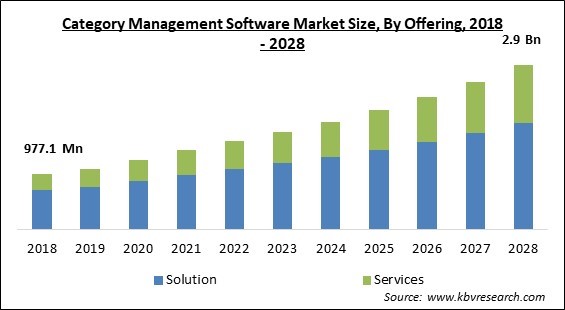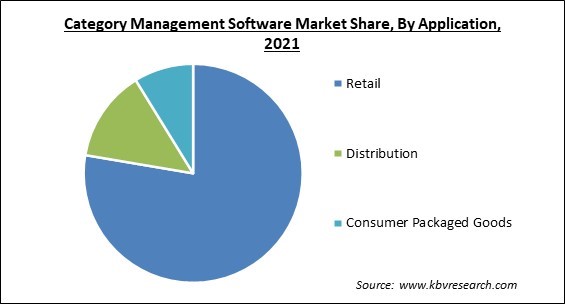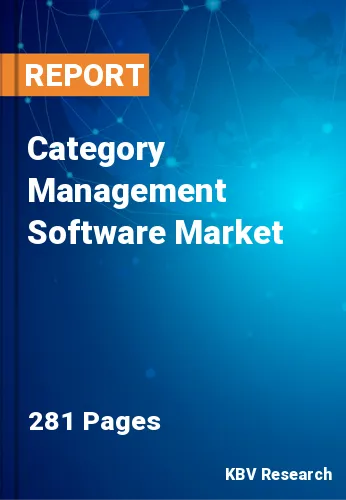The Global Category Management Software Market size is expected to reach $2.9 billion by 2028, rising at a market growth of 10.9% CAGR during the forecast period.
Category management is the technique of grouping related items into a single department or category and then taking on all commercial objectives for that category as a whole. These programs may encompass product lifecycle management, sales, merchandising, and other retail initiatives. The retail team's ability to acquire products, uphold supplier/buyer relationships, and carry out the procurement process can all be improved with the aid of category management.

There are four key components of successful products around which great category management techniques are founded. "The 4 Ps of category management"—Product, Pricing, Placement, and Promotion—consist of these factors. The performance of a category begins with the strategic sourcing of its products. Category managers use wholesale amounts to reduce prices when they purchase products. They also opt for the category as a whole to receive a better per-unit price.
Category managers must also compare the goods and costs offered by various vendors for their categories. Wholesale and retail prices both are taken into account. The wholesale price is the item's business-to-business (B2B) cost. The retail price, also known as business-to-consumer pricing, is the cost for the customer (B2C). To determine the optimum strategy for classifying their collections into unified categories within the store, category managers work in tandem with merchandising teams.
A smart category management system not only keeps track of these assortments but also takes into account the thoughtful arrangement of complementing goods for logical coherence within the aisle. Marketing strategies used to increase sales include retail promotions. Retailers must participate in promotional efforts both before and after things are put on sale to increase revenue and sales.
In order to meet consumer demand, numerous organizations have seen a significant increase in their use of category management, expanding its application. Every aspect of the industry is changing as a result of the digital revolution. A rising number of business vendors and third-party providers are adopting digital management solutions, driving the market forward. As a result, the shift in consumer behavior has enabled firms to adapt to the environmental and societal changes brought on by the pandemic. Thus, market growth is anticipated to be fueled by increasing digitalization and the adoption of category management software by key players.
Nations trade both finished goods and intermediary inputs in the contemporary global economic system. As a result, a sophisticated network of economic connections is built. Additionally, a lot of businesses are growing their geographic reach across numerous countries, which is advantageous to both businesses and the countries. The requirement for enhancing international logistics and shipment tracking is expanding along with the volume of international trade. Hence, international trade opens up new markets and exposes countries to goods and services that may not be available domestically.
Tracking, logging, and reporting are made simpler by centralizing and combining the data. Category management excels in these works. Through this software, one can understand the implications of spend analysis as well. Business look for additional options to outsource if their spend analysis reveals that it would be less expensive. Category management significantly helps in improving supplier connections and supply chain management. Building deeper relationships and gaining a better knowledge of how every category impacts risk control is made easier by helping to structure the procurement team's resources.
Organizations have extensively relied on pre-existing systems like enterprise resource planning (ERP), supply chain management (SCM), and transport management systems to manage business operations. Businesses manage their trade activities manually and with the help of the current management solutions. The main barriers to the widespread adoption of category management software are acknowledged to be these factors. The poor bandwidth and low budgets of businesses to develop and maintain new technologies, including category management solutions, are another hurdle inhibiting the adoption of this software.
On the basis of offering, the category management software market is fragmented into solution and services. The solution segment acquired the maximum revenue share in the category management software market in 2021. Many large enterprises like to employ category management software solution to streamline their functioning, and planning proactively to manage categories. The provision of in-depth analysis with the help of graphs and charts have made these solutions a much preferred technique to sort the departments effectively.

Based on deployment, the category management software market is divided into on-premise and cloud-based. The cloud-based deployment recorded the maximum revenue share in the category management software market in 2021. It is due to the suppliers' growing use of cloud-based category management software. Cloud-based category management software's pay-as-you-use features, superior scalability & integration, and low entry costs are the main drivers of the segment's growth.
On the basis of enterprise size, the category management software market is segmented into large enterprises and small & medium enterprises. The small and medium enterprises segment procured a substantial revenue share in the category management software market in 2021. Small and medium-sized businesses are implementing category management systems to improve their brand assortment planning in order to stimulate the growth of in-store shopping. As a result, the segment is rising due to the growing usage of this software by SMEs.
Based on application, the category management software market is classified into retail, distribution, and consumer packaged goods. The consumer-packaged goods segment procured a promising revenue share in the category management software market in 2021. The segment is expanding due to the rising need for management of supply chain software that is technologically integrated. Consumer product suppliers, wholesalers, and retailers are adjusting to shifting consumer preferences while continuing to develop steadily.
| Report Attribute | Details |
|---|---|
| Market size value in 2021 | USD 1.4 Billion |
| Market size forecast in 2028 | USD 2.9 Billion |
| Base Year | 2021 |
| Historical Period | 2018 to 2020 |
| Forecast Period | 2022 to 2028 |
| Revenue Growth Rate | CAGR of 10.9% from 2022 to 2028 |
| Number of Pages | 281 |
| Number of Tables | 510 |
| Report coverage | Market Trends, Revenue Estimation and Forecast, Segmentation Analysis, Regional and Country Breakdown, Companies Strategic Developments, Company Profiling |
| Segments covered | Offering, Application, Deployment Mode, Enterprise Size, Region |
| Country scope | US, Canada, Mexico, Germany, UK, France, Russia, Spain, Italy, China, Japan, India, South Korea, Singapore, Malaysia, Brazil, Argentina, UAE, Saudi Arabia, South Africa, Nigeria |
| Growth Drivers |
|
| Restraints |
|
Region-wise, the category management software market is analyzed across North America, Europe, Asia Pacific, and LAMEA. The Europe region acquired the maximum revenue share in the category management software market in 2021. Major drivers of the market growth include the increasing desire from retailers to link customer information to their distribution chain as well as the high priority given by European merchants to selection management.
Free Valuable Insights: Global Category Management Software Market size to reach USD 2.9 Billion by 2028
The market research report covers the analysis of key stake holders of the market. Key companies profiled in the report include Oracle Corporation, Epicor Software Corporation, Aptos, LLC, Board International S.A., Interactive Edge, 42 Technologies, Inc., Cognizant Technology Solutions Corporation, GEP Worldwide, Jagger LLC, and DotActiv (Pty) Ltd.
By Offering
By Application
By Deployment Mode
By Enterprise Size
By Geography
The global Category Management Software Market size is expected to reach $2.9 billion by 2028.
Rise In Global Trade Volume And Introduction Of New Products And Services are driving the market in coming years, however, Businesses Unwillingness To Adopt New Technologies Or Change Existing Systems restraints the growth of the market.
Oracle Corporation, Epicor Software Corporation, Aptos, LLC, Board International S.A., Interactive Edge, 42 Technologies, Inc., Cognizant Technology Solutions Corporation, GEP Worldwide, Jagger LLC, and DotActiv (Pty) Ltd.
The Retail segment acquired maximum revenue share in the Global Category Management Software Market by Application in 2021 thereby, achieving a market value of $2.2 billion by 2028.
The Large Enterprises segment is leading the Global Category Management Software Market by Enterprise Size in 2021 thereby, achieving a market value of $2.0 billion by 2028.
The Europe market dominated the Global Category Management Software Market by Region in 2021, and would continue to be a dominant market till 2028; thereby, achieving a market value of $1.0 billion by 2028.
Our team of dedicated experts can provide you with attractive expansion opportunities for your business.

